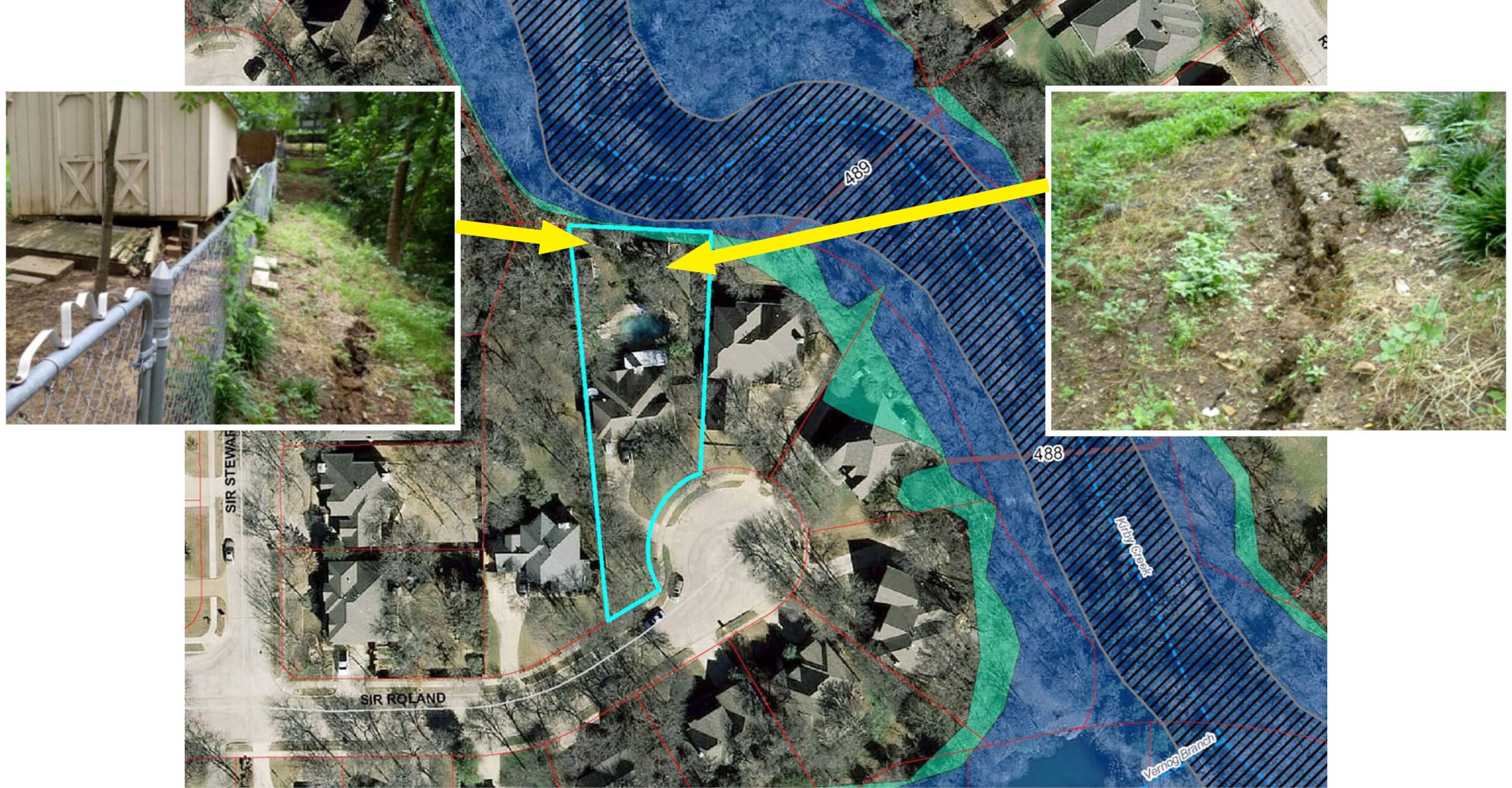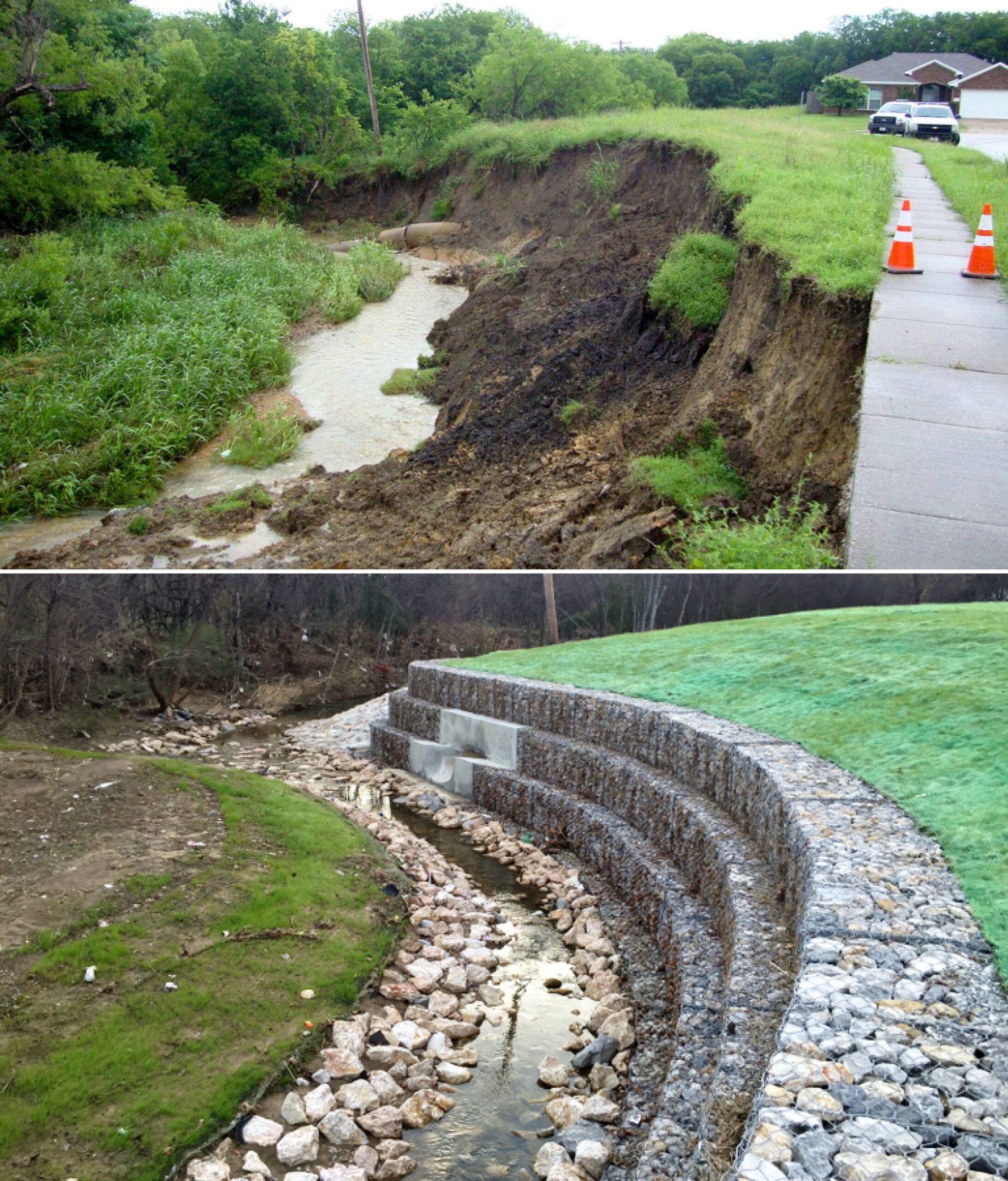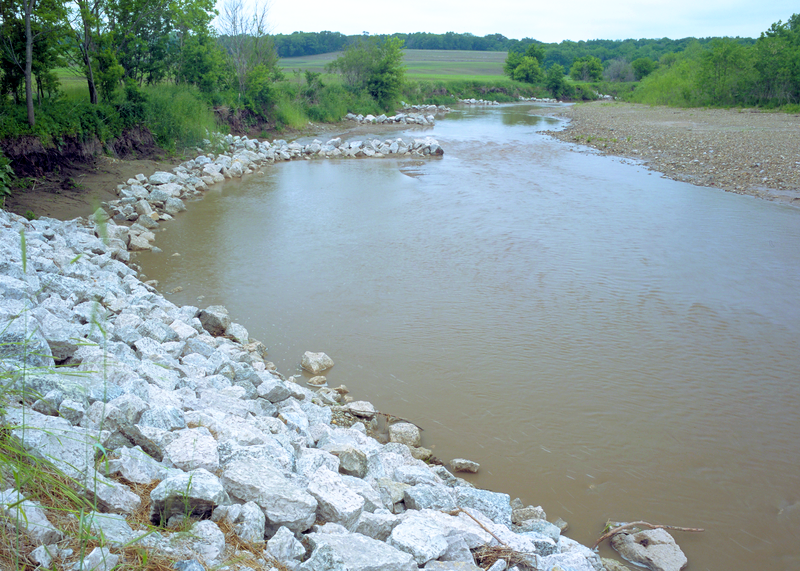Addressing Channel Erosion Early Can Provide Significant Long-Term Cost Savings
When it rains, it pours. North Texas has received an average yearly rainfall of more than 47 inches since 2015—that’s 17 inches more than the yearly average during the previous decade.
Nothing has changed in 2019, as 6.75 inches of rainfall were recorded in April and 8.15 inches during a soggy May.
More rainfall leads to higher, more intense flows in rivers and creeks. Greater, faster streamflow supports the transport of larger sediments downstream, and ultimately, erosion of the banks. Over time, stream erosion in urbanized areas can have damaging effects on valuable infrastructure such as roadways and utilities, in addition to the personal property of residents and businesses near the stream.
These damaging effects have been observed more frequently in the Dallas/Fort Worth area since the severe storm events of spring 2015.
Once channel erosion begins, each subsequent storm can cause additional damage. By evaluating existing channels and addressing erosion early, municipalities can limit the amount of repair needed and realize significant long-term maintenance cost savings.
Municipalities can utilize a three-step process to limit the impact of channel erosion:
-
A progression of analysis, assessment and alternatives for addressing immediate erosion problem areas should be explored as soon as possible to protect infrastructure and reduce long-term costs. Waiting for the right time will only allow the erosion to worsen.
-
The next step is expanding beyond isolated locations and performing a holistic examination of an entire stream channel to identify critical areas and develop a plan for monitoring, maintenance and restoration.
-
Finally, an analysis of all channels in a municipality should be performed to determine the most cost-effective manner to monitor critical areas, prioritize projects and make systemwide improvements.
Erosion can be found along this urbanized stream corridor, shown in relation to a floodplain map.
The Erosion Process
As a channel starts eroding, it begins a downcutting effect as pInsights are moved from sections of the channel with higher velocities to downstream areas where velocities are low. The channel has begun a geomorphologic process to try and reach a new equilibrium state. The water moving through the channel wants to flatten it out, and it does this by cutting down the stream bed and digging deeper with a constant progression from downstream to upstream.
Eventually, it reaches a point where it gets to a hard substratum, and the processes to cut down have changed to a new process. At that point, a once narrow, incised channel starts to widen and meander to accommodate higher flows that it is receiving. As the flows continue to increase with even more impervious development, the stream erosion evolution continues as it again cuts deeper, wider and flatter to reach a new equilibrium state. These natural channel processes can persist over decades and result in problems to adjacent infrastructure and properties unless addressed.
Halff has successfully engaged in projects large and small that solve various stream erosion issues. What are these primary issues?
-
A natural stream is meandering and encroaching on somebody’s property.
-
An unprotected culvert crossing is scouring the downstream side of a roadway, leading to undermining of the culvert and/or roadway embankment.
-
The stream is exposing a utility. Erosion affects utilities that run parallel to a creek, including exposing sanitary sewer lines. This exposure can reduce stability, causing breaks and allowing sanitary sewer flows into the creek.
-
As downcutting occurs, a headwall is no longer supported by the ground underneath and can be separated from its storm drain.
-
The erosion is affecting a utility crossing the creek. Numerous issues can occur—damage to supports and straps, pipe exposure, buildup of debris on the upstream side, and more exposure of unsupported sections of pipe, making the utility’s infrastructure less stable.
A gabion wall, with rip rap installed in the channel, form hard-armor solutions for channel grade stabilization.
Hard-Armor and Soft-Armor Solutions
Solutions for bank stabilization include soft-surface armor or hard-surface armor. Channel grade stabilization solutions primarily include hard-surface armor.
Soft-armor solutions can include grass and other vegetation used on flatter slopes. It is essential that vegetation be established for it to be successful. Therefore, biodegradable or permanent turf reinforcement matting is often implemented with seed spread underneath. Sometimes sod is used, and other times adjacent vegetation that thrives in the stream is transplanted to the bank areas needing stabilization. One detriment is soft-armor solutions take time to strengthen so they must be able to withstand erosive velocities prior to vegetation establishment. Tree canopies along stream corridors can make it difficult for vegetation to establish in shaded areas.
Hard-armor solutions to protect against future erosion can include gabions, precast block retaining walls, rock rip rap and rock chutes for channel grade stabilization.
Engineers look for locations in the creek where water velocities are high and flows are damaging—often on the outside of a bend—to implement bank stabilization solutions. Sometimes a solution can be built in the creek bed, such as a bendway weir, to redirect high velocities to less-impacted stream areas so they aren’t scouring a utility line or a property owner’s slope, for example.
A bendway weir is a rock structure placed along the outer bank of a bend to alleviate stresses on the bank.
One way to control the downcutting effect is to construct hardpoints along the channel at key locations. A hardpoint such as a culvert, dam or rock chute will stop the migration of the downcutting effects and prevent the channel from incising upstream, thus controlling the current flowline and top of channel limits.
Cities can get ahead of erosion impacts by establishing erosion hazard setbacks so new developments remain in the clear over time. Implementing an erosion ordinance can also help cities to better prioritize addressing public erosion needs over private erosion issues, avoiding high costs of solutions to address a single owner’s issue. Voluntary buyouts may be a solution for individual properties where a public improvement cannot be implemented and where private improvements are too costly to address the individual need.
Write to Info-PublicWorks@Halff.com to learn more about Halff’s stream erosion stabilization and restoration solutions.






